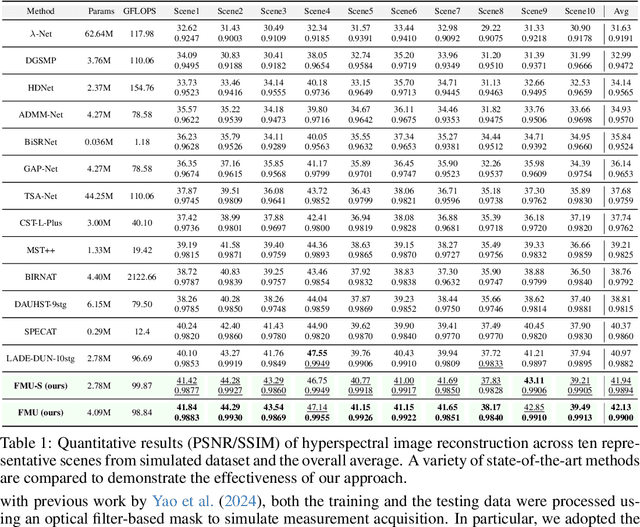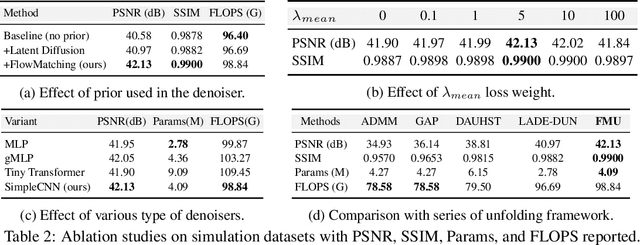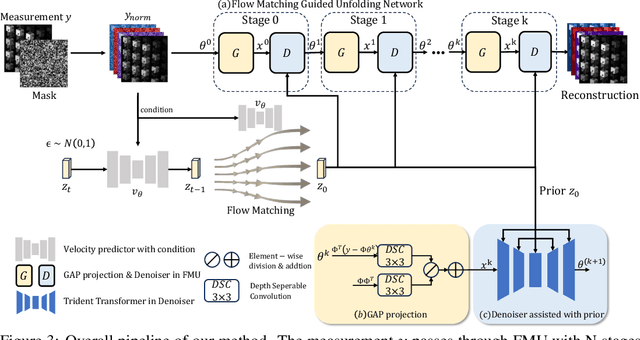Xiaokang Yang
Scaling Up Occupancy-centric Driving Scene Generation: Dataset and Method
Oct 27, 2025Abstract:Driving scene generation is a critical domain for autonomous driving, enabling downstream applications, including perception and planning evaluation. Occupancy-centric methods have recently achieved state-of-the-art results by offering consistent conditioning across frames and modalities; however, their performance heavily depends on annotated occupancy data, which still remains scarce. To overcome this limitation, we curate Nuplan-Occ, the largest semantic occupancy dataset to date, constructed from the widely used Nuplan benchmark. Its scale and diversity facilitate not only large-scale generative modeling but also autonomous driving downstream applications. Based on this dataset, we develop a unified framework that jointly synthesizes high-quality semantic occupancy, multi-view videos, and LiDAR point clouds. Our approach incorporates a spatio-temporal disentangled architecture to support high-fidelity spatial expansion and temporal forecasting of 4D dynamic occupancy. To bridge modal gaps, we further propose two novel techniques: a Gaussian splatting-based sparse point map rendering strategy that enhances multi-view video generation, and a sensor-aware embedding strategy that explicitly models LiDAR sensor properties for realistic multi-LiDAR simulation. Extensive experiments demonstrate that our method achieves superior generation fidelity and scalability compared to existing approaches, and validates its practical value in downstream tasks. Repo: https://github.com/Arlo0o/UniScene-Unified-Occupancy-centric-Driving-Scene-Generation/tree/v2
FieldGen: From Teleoperated Pre-Manipulation Trajectories to Field-Guided Data Generation
Oct 23, 2025Abstract:Large-scale and diverse datasets are vital for training robust robotic manipulation policies, yet existing data collection methods struggle to balance scale, diversity, and quality. Simulation offers scalability but suffers from sim-to-real gaps, while teleoperation yields high-quality demonstrations with limited diversity and high labor cost. We introduce FieldGen, a field-guided data generation framework that enables scalable, diverse, and high-quality real-world data collection with minimal human supervision. FieldGen decomposes manipulation into two stages: a pre-manipulation phase, allowing trajectory diversity, and a fine manipulation phase requiring expert precision. Human demonstrations capture key contact and pose information, after which an attraction field automatically generates diverse trajectories converging to successful configurations. This decoupled design combines scalable trajectory diversity with precise supervision. Moreover, FieldGen-Reward augments generated data with reward annotations to further enhance policy learning. Experiments demonstrate that policies trained with FieldGen achieve higher success rates and improved stability compared to teleoperation-based baselines, while significantly reducing human effort in long-term real-world data collection. Webpage is available at https://fieldgen.github.io/.
Expertise need not monopolize: Action-Specialized Mixture of Experts for Vision-Language-Action Learning
Oct 16, 2025Abstract:Vision-Language-Action (VLA) models are experiencing rapid development and demonstrating promising capabilities in robotic manipulation tasks. However, scaling up VLA models presents several critical challenges: (1) Training new VLA models from scratch demands substantial computational resources and extensive datasets. Given the current scarcity of robot data, it becomes particularly valuable to fully leverage well-pretrained VLA model weights during the scaling process. (2) Real-time control requires carefully balancing model capacity with computational efficiency. To address these challenges, We propose AdaMoE, a Mixture-of-Experts (MoE) architecture that inherits pretrained weights from dense VLA models, and scales up the action expert by substituting the feedforward layers into sparsely activated MoE layers. AdaMoE employs a decoupling technique that decouples expert selection from expert weighting through an independent scale adapter working alongside the traditional router. This enables experts to be selected based on task relevance while contributing with independently controlled weights, allowing collaborative expert utilization rather than winner-takes-all dynamics. Our approach demonstrates that expertise need not monopolize. Instead, through collaborative expert utilization, we can achieve superior performance while maintaining computational efficiency. AdaMoE consistently outperforms the baseline model across key benchmarks, delivering performance gains of 1.8% on LIBERO and 9.3% on RoboTwin. Most importantly, a substantial 21.5% improvement in real-world experiments validates its practical effectiveness for robotic manipulation tasks.
Flow-Matching Guided Deep Unfolding for Hyperspectral Image Reconstruction
Oct 02, 2025



Abstract:Hyperspectral imaging (HSI) provides rich spatial-spectral information but remains costly to acquire due to hardware limitations and the difficulty of reconstructing three-dimensional data from compressed measurements. Although compressive sensing systems such as CASSI improve efficiency, accurate reconstruction is still challenged by severe degradation and loss of fine spectral details. We propose the Flow-Matching-guided Unfolding network (FMU), which, to our knowledge, is the first to integrate flow matching into HSI reconstruction by embedding its generative prior within a deep unfolding framework. To further strengthen the learned dynamics, we introduce a mean velocity loss that enforces global consistency of the flow, leading to a more robust and accurate reconstruction. This hybrid design leverages the interpretability of optimization-based methods and the generative capacity of flow matching. Extensive experiments on both simulated and real datasets show that FMU significantly outperforms existing approaches in reconstruction quality. Code and models will be available at https://github.com/YiAi03/FMU.
FlashEdit: Decoupling Speed, Structure, and Semantics for Precise Image Editing
Sep 26, 2025Abstract:Text-guided image editing with diffusion models has achieved remarkable quality but suffers from prohibitive latency, hindering real-world applications. We introduce FlashEdit, a novel framework designed to enable high-fidelity, real-time image editing. Its efficiency stems from three key innovations: (1) a One-Step Inversion-and-Editing (OSIE) pipeline that bypasses costly iterative processes; (2) a Background Shield (BG-Shield) technique that guarantees background preservation by selectively modifying features only within the edit region; and (3) a Sparsified Spatial Cross-Attention (SSCA) mechanism that ensures precise, localized edits by suppressing semantic leakage to the background. Extensive experiments demonstrate that FlashEdit maintains superior background consistency and structural integrity, while performing edits in under 0.2 seconds, which is an over 150$\times$ speedup compared to prior multi-step methods. Our code will be made publicly available at https://github.com/JunyiWuCode/FlashEdit.
Discrete Diffusion VLA: Bringing Discrete Diffusion to Action Decoding in Vision-Language-Action Policies
Aug 27, 2025Abstract:Vision-Language-Action (VLA) models adapt large vision-language backbones to map images and instructions to robot actions. However, prevailing VLA decoders either generate actions autoregressively in a fixed left-to-right order or attach continuous diffusion or flow matching heads outside the backbone, demanding specialized training and iterative sampling that hinder a unified, scalable architecture. We present Discrete Diffusion VLA, a single-transformer policy that models discretized action chunks with discrete diffusion and is trained with the same cross-entropy objective as the VLM backbone. The design retains diffusion's progressive refinement paradigm while remaining natively compatible with the discrete token interface of VLMs. Our method achieves an adaptive decoding order that resolves easy action elements before harder ones and uses secondary remasking to revisit uncertain predictions across refinement rounds, which improves consistency and enables robust error correction. This unified decoder preserves pretrained vision language priors, supports parallel decoding, breaks the autoregressive bottleneck, and reduces the number of function evaluations. Discrete Diffusion VLA achieves 96.3% avg. SR on LIBERO, 71.2% visual matching on SimplerEnv Fractal and 49.3% overall on SimplerEnv Bridge, improving over both autoregressive and continuous diffusion baselines. These findings indicate that discrete-diffusion action decoder supports precise action modeling and consistent training, laying groundwork for scaling VLA to larger models and datasets.
NEARL-CLIP: Interacted Query Adaptation with Orthogonal Regularization for Medical Vision-Language Understanding
Aug 06, 2025Abstract:Computer-aided medical image analysis is crucial for disease diagnosis and treatment planning, yet limited annotated datasets restrict medical-specific model development. While vision-language models (VLMs) like CLIP offer strong generalization capabilities, their direct application to medical imaging analysis is impeded by a significant domain gap. Existing approaches to bridge this gap, including prompt learning and one-way modality interaction techniques, typically focus on introducing domain knowledge to a single modality. Although this may offer performance gains, it often causes modality misalignment, thereby failing to unlock the full potential of VLMs. In this paper, we propose \textbf{NEARL-CLIP} (i\underline{N}teracted qu\underline{E}ry \underline{A}daptation with o\underline{R}thogona\underline{L} Regularization), a novel cross-modality interaction VLM-based framework that contains two contributions: (1) Unified Synergy Embedding Transformer (USEformer), which dynamically generates cross-modality queries to promote interaction between modalities, thus fostering the mutual enrichment and enhancement of multi-modal medical domain knowledge; (2) Orthogonal Cross-Attention Adapter (OCA). OCA introduces an orthogonality technique to decouple the new knowledge from USEformer into two distinct components: the truly novel information and the incremental knowledge. By isolating the learning process from the interference of incremental knowledge, OCA enables a more focused acquisition of new information, thereby further facilitating modality interaction and unleashing the capability of VLMs. Notably, NEARL-CLIP achieves these two contributions in a parameter-efficient style, which only introduces \textbf{1.46M} learnable parameters.
Perceiving and Acting in First-Person: A Dataset and Benchmark for Egocentric Human-Object-Human Interactions
Aug 06, 2025Abstract:Learning action models from real-world human-centric interaction datasets is important towards building general-purpose intelligent assistants with efficiency. However, most existing datasets only offer specialist interaction category and ignore that AI assistants perceive and act based on first-person acquisition. We urge that both the generalist interaction knowledge and egocentric modality are indispensable. In this paper, we embed the manual-assisted task into a vision-language-action framework, where the assistant provides services to the instructor following egocentric vision and commands. With our hybrid RGB-MoCap system, pairs of assistants and instructors engage with multiple objects and the scene following GPT-generated scripts. Under this setting, we accomplish InterVLA, the first large-scale human-object-human interaction dataset with 11.4 hours and 1.2M frames of multimodal data, spanning 2 egocentric and 5 exocentric videos, accurate human/object motions and verbal commands. Furthermore, we establish novel benchmarks on egocentric human motion estimation, interaction synthesis, and interaction prediction with comprehensive analysis. We believe that our InterVLA testbed and the benchmarks will foster future works on building AI agents in the physical world.
MEDTalk: Multimodal Controlled 3D Facial Animation with Dynamic Emotions by Disentangled Embedding
Jul 08, 2025Abstract:Audio-driven emotional 3D facial animation aims to generate synchronized lip movements and vivid facial expressions. However, most existing approaches focus on static and predefined emotion labels, limiting their diversity and naturalness. To address these challenges, we propose MEDTalk, a novel framework for fine-grained and dynamic emotional talking head generation. Our approach first disentangles content and emotion embedding spaces from motion sequences using a carefully designed cross-reconstruction process, enabling independent control over lip movements and facial expressions. Beyond conventional audio-driven lip synchronization, we integrate audio and speech text, predicting frame-wise intensity variations and dynamically adjusting static emotion features to generate realistic emotional expressions. Furthermore, to enhance control and personalization, we incorporate multimodal inputs-including text descriptions and reference expression images-to guide the generation of user-specified facial expressions. With MetaHuman as the priority, our generated results can be conveniently integrated into the industrial production pipeline.
MedSeg-R: Reasoning Segmentation in Medical Images with Multimodal Large Language Models
Jun 12, 2025Abstract:Medical image segmentation is crucial for clinical diagnosis, yet existing models are limited by their reliance on explicit human instructions and lack the active reasoning capabilities to understand complex clinical questions. While recent advancements in multimodal large language models (MLLMs) have improved medical question-answering (QA) tasks, most methods struggle to generate precise segmentation masks, limiting their application in automatic medical diagnosis. In this paper, we introduce medical image reasoning segmentation, a novel task that aims to generate segmentation masks based on complex and implicit medical instructions. To address this, we propose MedSeg-R, an end-to-end framework that leverages the reasoning abilities of MLLMs to interpret clinical questions while also capable of producing corresponding precise segmentation masks for medical images. It is built on two core components: 1) a global context understanding module that interprets images and comprehends complex medical instructions to generate multi-modal intermediate tokens, and 2) a pixel-level grounding module that decodes these tokens to produce precise segmentation masks and textual responses. Furthermore, we introduce MedSeg-QA, a large-scale dataset tailored for the medical image reasoning segmentation task. It includes over 10,000 image-mask pairs and multi-turn conversations, automatically annotated using large language models and refined through physician reviews. Experiments show MedSeg-R's superior performance across several benchmarks, achieving high segmentation accuracy and enabling interpretable textual analysis of medical images.
 Add to Chrome
Add to Chrome Add to Firefox
Add to Firefox Add to Edge
Add to Edge